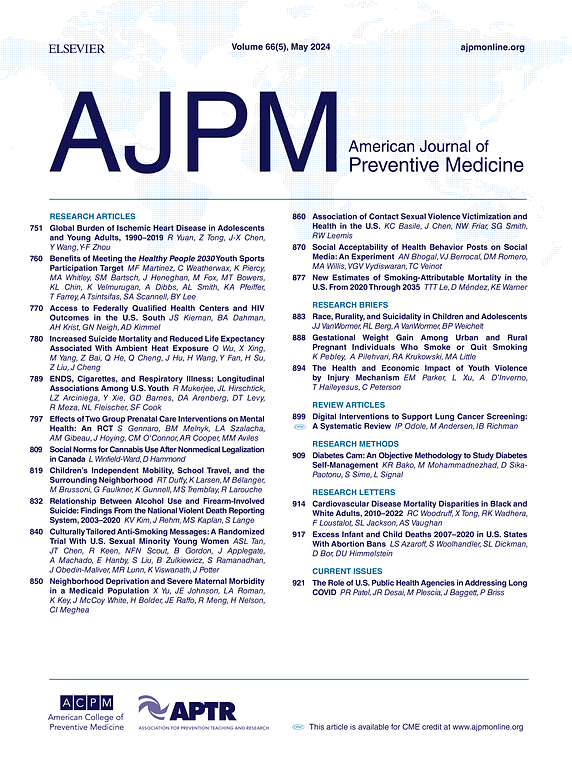Long COVID and New Onset Disability Nearly 2 Years After Initial Infection
IF 4.3
2区 医学
Q1 MEDICINE, GENERAL & INTERNAL
引用次数: 0
Abstract
Introduction
The objective of this study was to determine the prevalence of ongoing long COVID symptoms and related disability in a population-based cohort nearly 2 years after SARS-CoV-2 infection.
Methods
Six domains of age-standardized disability (i.e., mobility, cognition, independent living, vision, hearing, self-care) were assessed by ongoing long COVID status using cohort data from a population-based survey of adults with COVID-19 onset from March–December 2020 in Michigan. Baseline data were collected June 2020–October 2021 and follow-up data were collected January–November 2022. Associations between ongoing long COVID and each domain of disability were also examined using adjusted modified Poisson regression models. Analyses were conducted 2024–2025.
Results
Nearly 2 years after initial infection, 24.0% of 1,547 respondents reported ongoing long COVID symptoms. When comparing disability status 4 weeks prior to COVID-19 illness to the time of the follow-up survey, respondents with ongoing long COVID symptoms had large increases in the prevalence of cognition (8.8% to 45.3%), mobility (12.7% to 40.0%), independent living (4.7% to 20.7%), and self-care (2.1% to 10.9%) disability, and more modest increases in the prevalence of vision and hearing disability. Respondents without ongoing long COVID symptoms experienced smaller increases in disability prevalence. In regression models, ongoing long COVID was associated with higher prevalence of all 6 disability domains.
Conclusions
The ongoing burden of long COVID and related disability is substantial and warrants increased attention by the public health and medical communities.
初次感染后近2年的长期COVID和新发残疾。
本研究的目的是确定在SARS-CoV-2感染近两年后,以人群为基础的队列中持续的长COVID症状和相关残疾的患病率。方法:利用2020年3月至12月密歇根州一项基于人群的COVID-19发病成人调查的队列数据,通过持续的长期COVID状态评估6个年龄标准化残疾领域(即行动能力、认知能力、独立生活、视力、听力、自我护理)。基线数据收集于2020年6月至2021年10月,随访数据收集于2022年1月至11月。还使用调整后的修正泊松回归模型检查了正在进行的长COVID与每个残疾领域之间的关联。分析时间为2024-2025年。结果:在首次感染近两年后,1547名受访者中有24.0%的人报告了持续的长时间COVID症状。在将COVID-19发病前四周的残疾状况与随访调查时进行比较时,持续出现长时间COVID症状的受访者在认知残疾(8.8%至45.3%)、行动能力(12.7%至40.0%)、独立生活(4.7%至20.7%)和自我护理(2.1%至10.9%)方面的患病率大幅增加,而视力和听力残疾的患病率增加幅度较小。没有长期COVID症状的受访者的残疾患病率增幅较小。在回归模型中,持续的长COVID与所有六个残疾领域的较高患病率相关。结论:长冠状病毒病和相关残疾的持续负担是巨大的,值得公共卫生和医学界加强关注。
本文章由计算机程序翻译,如有差异,请以英文原文为准。
求助全文
约1分钟内获得全文
求助全文
来源期刊

American Journal of Preventive Medicine
医学-公共卫生、环境卫生与职业卫生
CiteScore
8.60
自引率
1.80%
发文量
395
审稿时长
32 days
期刊介绍:
The American Journal of Preventive Medicine is the official journal of the American College of Preventive Medicine and the Association for Prevention Teaching and Research. It publishes articles in the areas of prevention research, teaching, practice and policy. Original research is published on interventions aimed at the prevention of chronic and acute disease and the promotion of individual and community health.
Of particular emphasis are papers that address the primary and secondary prevention of important clinical, behavioral and public health issues such as injury and violence, infectious disease, women''s health, smoking, sedentary behaviors and physical activity, nutrition, diabetes, obesity, and substance use disorders. Papers also address educational initiatives aimed at improving the ability of health professionals to provide effective clinical prevention and public health services. Papers on health services research pertinent to prevention and public health are also published. The journal also publishes official policy statements from the two co-sponsoring organizations, review articles, media reviews, and editorials. Finally, the journal periodically publishes supplements and special theme issues devoted to areas of current interest to the prevention community.
 求助内容:
求助内容: 应助结果提醒方式:
应助结果提醒方式:


